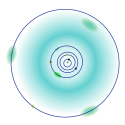2023 FW14 is a small asteroid orbiting near the L4 point of Mars (60 degrees ahead of Mars on its orbit). As of March 2024, it is the second known asteroid to orbit the leading L4 point of Mars together with (121514) 1999 UJ7, although at least 15 other asteroids orbit Mars's trailing L5 point, including 5261 Eureka, (101429) 1998 VF31, and 2007 NS2.[3] Not only does 2023 FW14 orbit on the other side of Mars from other similar asteroids, its spectrum is different as well, but close to that of (121514) 1999 UJ7.[3]
| Discovery[1] | |
|---|---|
| Discovered by | Pan-STARRS 2 |
| Discovery site | Haleakala Observatory |
| Discovery date | 18 March 2023 |
| Designations | |
Martian L4  | |
| Orbital characteristics[2] | |
| Epoch 13 September 2023 (JD 2460200.5) | |
| Uncertainty parameter 0 | |
| Observation arc | 5503 days (15.07 yr) |
| Aphelion | 1.764696353 AU (263.9948168 Gm) |
| Perihelion | 1.2828435 AU (191.91066 Gm) |
| 1.523769939 AU (227.9527383 Gm) | |
| Eccentricity | 0.15811207 |
| 1.88099354 yr (687.032891 d) | |
| 26.03608° | |
| 0° 31m 26.373s / day | |
| Inclination | 13.272714° |
| 21.84773° | |
| 245.29506° | |
| Earth MOID | 0.331663 AU (49.6161 Gm) |
| Jupiter MOID | 3.31104 AU (495.325 Gm) |
| Physical characteristics | |
| Dimensions | ~320 m[3] |
| 0.047 | |
| X[3] | |
| 21.6[2] | |
Orbit edit
2023 FW14 orbits around the L4 point of Mars in a somewhat stable orbit and it may be affected by the Yarkovsky effect. It is far less stable than (121514) 1999 UJ7.[3] Its initial orbit[1] was eventually improved when precovery images were found.[4] Its current orbit is of the Amor type.[5] Its orbital evolution into the past strongly suggests that it cannot be a primordial trojan like Eureka.[3]
Physical characteristics edit
Its spectrum suggests that it is an X-type asteroid, which is different from 5261 Eureka and 1998 VF31 but compatible with that of (121514) 1999 UJ7, and this is somewhat puzzling since different mineral compositions suggest different origins for the two groups of asteroids.[3] Asteroid 2023 FW14 might have been captured from the Mars-crossing near-Earth asteroid population; alternatively, it might be a fragment of (121514) 1999 UJ7 produced in situ nearly 1 Myr ago.[3]
See also edit
References edit
- ^ a b "MPEC 2023-G87 : 2023 FW14". IAU Minor Planet Center. 15 April 2023. Retrieved 8 March 2024. (K23F14W)
- ^ a b "JPL Small-Body Database Browser: (2023 FW14)" (last observation: 2023-04-22; arc: 5503 days (47 obs)). Jet Propulsion Laboratory. Retrieved 8 March 2024.
- ^ a b c d e f g h de la Fuente Marcos, Raúl; de León, Julia; de la Fuente Marcos, Carlos; Alarcon, Miguel R.; Licandro, Javier; Serra-Ricart, Miquel; Geier, Stefan; Cabrera-Lavers, Antonio (21 March 2024). "Dynamics of 2023 FW14, the second L4 Mars trojan, and a physical characterization using the 10.4 m Gran Telescopio Canarias". Astronomy & Astrophysics, Letters to the Editor. 683 (1): L14 (6 pages). arXiv:2403.04061. Bibcode:2024A&A...683L..14D. doi:10.1051/0004-6361/202449688.
{{cite journal}}: CS1 maint: date and year (link) - ^ "MPEC 2023-H105 : 2023 FW14". IAU Minor Planet Center. 19 April 2023. Retrieved 8 March 2024. ((K23F14W)
- ^ "2023 FW14 Orbit". Minor Planet Center. Retrieved 8 March 2024.
External links edit
- 2023 FW14 at AstDyS-2, Asteroids—Dynamic Site
- 2023 FW14 at the JPL Small-Body Database